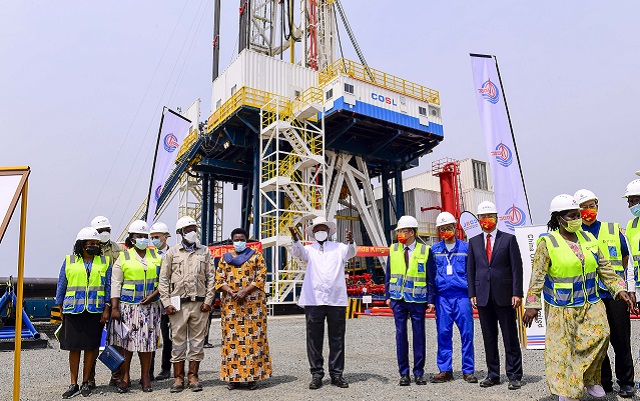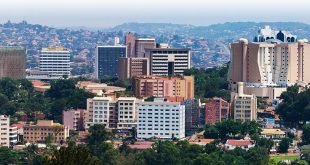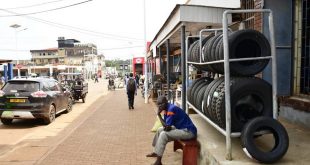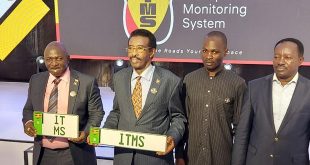
Hoima, Uganda | THE INDEPENDENT | French energy giant TotalEnergies has kicked off drilling operations at one of the wells in the Murchison Falls National Park. Drilling Engineers at Jobi-Rii well on Wednesday confirmed that they had reached the hydrocarbons not so far deep as had been expected.
Unlike King Fisher where wells are 4-7 kilometers, drillers at Tilenga found oil less than two kilometers deep. Alex Nyombi, the Director of Development and Production at the Petroleum Authorityof Uganda (PAU), said drillings oil in Tilenga is likely to be cheaper than King Fisher operated by China National Offshore Oil Corporation or CNOOC Group.
“King Fisher wells are quite deep. Some of the wells go up to seven kilometers. So a well here is going to cost relatively much lower than a single well in King Fisher,” said Nyombi. Mwesigwa Emmanuel, one of the PAU engineers monitoring the drilling operations at the Jobi-Rii well pad said after the successful drilling exercise, the drillers at the site were preparing the casings to make the wells ready for oil and gas extraction from the ground.
About 18 wells will be established at Jobi-Rii. Totalenergies plans to drill over 426 wells, which will include (200 water injector wells and 196 oil producer wells on 31 well-pads located in Nwoya and Buliisa districts. The SINOPEC 1503 at Jobi-Rii is a state-of-the-art automated rig known as the “walking rig” that walks on hydraulic feet between drill sites. According to the engineers at the site, its portability makes it easy to drill many wells from the same drill pad.
The rig stands at about sixty-meter high in the middle of the national. It is painted with beige color to resemble the surrounding Savannah grasslands. Unlike in other oil-producing countries, the well pads in Tilenga and King Fishers projects will not have the noise-making pump that is commonly used to extract oil commonly known as a nodding donkey.

There had been concerns that old-fashioned nodding donkey technology would be too noisy and possibly force wildlife to migrate. Nyombi told URN that the rigs have been fitted with technologies to minimize the noise in the national park and its surroundings. The Prime Minister of Buganda, Charles Peter together with some members of his cabinet have been touring the oil and gas installations in the Albertine.
Mayiga said he was happy that the choice of the color of the rig was part of attempts to take care of conservation concerns. “This is a national park and it is important that whatever activities regarding oil consider the life of the animals. The habitat of the animals. It is necessary for this industry to ensure that nature isn’t disturbed by man’s love for oil” said Mayiga.
Wildlife like giraffes, antelopes, bushbucks, and warthogs were seen in the vicinity of the well pads grazing seemingly not bothered by the activities in a fenced area. In 2012, TotalEnergies EP Uganda promises to use environmentally friendly technology to develop oil resources in sensitive areas. It also promised to limit the number of well pads to ensure that oil activities limit a footprint on an ecologically sensitive area like the Murchison.
According to Nyombi, drilling 14-18 on a single well pad in the case of Uganda is because the oil in the Albertine does not flow easily. “These reservoirs are extensive and the oil takes a long time to move from one point to another. So if you have a reservoir from point A-B. If you only drill at point A, the oil at point B may never drain,” Nyombi explained.
Production from the Tilenga oil development project is expected to begin in 2025 and is forecast to peak in 2028, at approximately 190,000 bpd of crude oil and condensate. Based on economic assumptions, the production will continue until the field reaches its economic limit in 2057. The drilling at Tilenga comes almost six months after President Museveni launched a similar exercise at King Fisher operated by CNOOC. Thirty-one wells will be drilled King Fisher project located at the shores of Lake Albert in Kikuube district.
The Kingfisher field, operated by the state-owned China National Offshore Oil Corporation (CNOOC), is expected to produce 40,000 barrels of oil per day at its peak. Tony Ojok, a Petrol Physicist with the Petroleum Authority who monitors drilling at King Fisher recently told URN that the drilling exercise there was progressing. Ojok explained the fact that the drilling of wells is completed does not mean that oil is now flowing out of the ground.
He said King Fisher and Tilenga projects are yet to construct the Central Processing Facilities(CPF)to purify the crude once pulled out of the ground. “Currently we are only drilling wells we are not extracting anything. We are drilling and preparing the wells for production,”
So according to Ojok, the acceleration drillings at the $10 billion Lake Albert Development project comprising Tilenga and King Fisher is a significant development in Uganda’s oil and gas sector.
Because the Central Processing Facilities are not in place at both sites, all the drilled wells will be shut in until completed. Shutting in wells is a normal practice n the oil and gas sector. It can occur due to a lack of available transportation facilities, available markets, or other reasons.
*****
URN
 The Independent Uganda: You get the Truth we Pay the Price
The Independent Uganda: You get the Truth we Pay the Price


